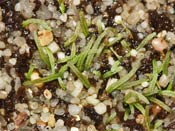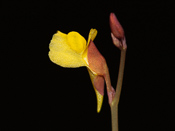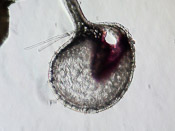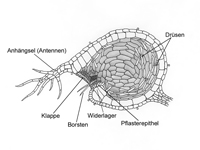Cultivation
Utricularia
The genus Utricularia (bladderwort) includes more than 220 species, making it the largest genus among carnivorous plants. Unfortunately, about half of the species are not yet in cultivation. This may be due to the fact that the traps of these plants are hidden beneath the substrate (or under water). Small prey animals are sucked into the approx. 0.5 to 5 mm large traps (maybe the fastest movement in the plant kingdom?). The flowers leave nothing to be desired in terms of color: there are yellow, blue, red, pink, patterned, ... from small to large, everything is included. Some flowers (e.g. those in the section Orchidioides) even resemble orchids. If they should not bloom, they sometimes look a bit unspectacular, which is why I have been asked several times whether I cultivate moss. Nevertheless, this genus is one of my favorite genera.
Here some general information and some selected species in detail:
Epiphytes - Tubers - Terrestrial species (subtropical) - Terrestrial species (tropical)
Epiphytes and orchid-like species
Light: bright - partially shady
Humidity: >70 %
Temperature: Day: 20-25 °C, night: 10-15 °C, colder during winter
Substrate: Peat-sand-perlite-sphagnum mixture or pure Sphagnum (dead or alive)
Watering: Pot in about 1 cm of water or less, water from above
Propagation: Division, seeds
Utricularia alpina
My own experience:
Utricularia alpina was my first step on the way to Utricularia quelchii.
In my opinion, U. alpina is the simplest of all plants in the section Orchidioides.
At first I had no problems with this species and it even flowered, but after a while a white coating formed on the leaves: powdery mildew.
I tried many remedies against powdery mildew, but a few days later this white stuff kept popping up. So I decided to put the plant in my highland terrarium.
I also removed the infected leaves to prevent the disease from spreading.
After a while the plant continued to grow quickly.
In the course of time I acquired various forms of this species. They also flower in great numbers. Some experiments with grid pots were also very successful.
Sphagnum is particularly suitable as a substrate.
Level of difficulty: 
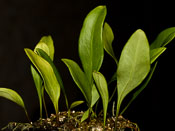
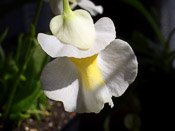
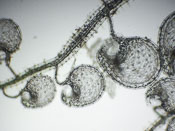
Utricularia campbelliana
My own experience:
At first I didn't dare to buy this species because the cultivation is very demanding.
But when I could be sure that I could offer these conditions to this relatively rare plant, nothing stood in the way of picking it up.
In the beginning everything went smoothly, but after a few days the plant lost all of its leaves. But a day later, the first new leaf was formed.
After that it grew relatively well. I then kept the plant a bit drier, since it was probably too wet at first.
Unfortunately, this plant disappeared after a few months despite the irrigation system.
After a while I got another plant. But I also lost it after about 2 years.
Now I own this beautiful species again for some time, which I cultivate in dead and living sphagnum.
Since I now strictly hold on to the night temperatures, it finally grows better than before and also flowers every now and then.
Level of difficulty: 
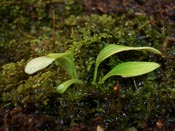
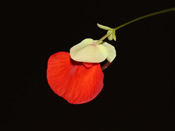
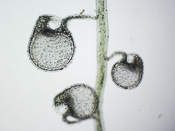
Utricularia longifolia
My own experience:
This bladderwort forms the largest leaves of the genus. They can become over 1 m long.
At the beginning I had no problems with this plant (maybe only space problems) and it even flowered. The flower stem almost reached my terrarium cover.
So I had to put the plant in a sunny spot on the window sill, because it was already touching the fluorescent tubes.
Since I had to move the plant to another place for a long time, it got powdery mildew. Fortunately, the flower was not affected.
Unfortunately the powdery mildew gained the upper hand and the plant quickly died down.
Some time later my first U. endresii turned out to be a wrongly determined U. longifolia.
No wonder that the plant grew like crazy and completely rooted through a 9-pot within a year. But this plant was also attacked by powdery mildew.
Level of difficulty: 
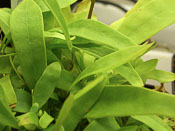
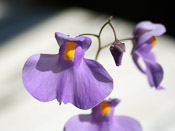
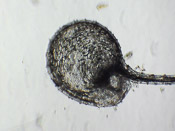
Utricularia nelumbifolia
My own experience:
The plant was initially in my highland terrarium for some time. Unfortunately, it didn't feel very comfortable there, which is why I put it on the windowsill (south side) after a few months.
There it developed much better. Maybe it was also because it was relatively dry in the terrarium. I regularly flooded the plant on the windowsill.
After a cool winter, the plant finally developed a flower stalk.
After successful pollination, I received many seeds (see pollination) that germinated in record time.
A really spectacular feature of this species.
Level of difficulty: 
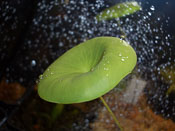
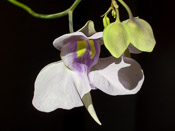
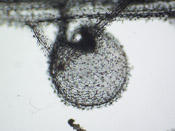
Utricularia quelchii
My own experience:
1449/5000
This plant grows on the table mountains (tepuis) of Venezuela and is relatively rare in cultivation.
It has always been one of my big goals to cultivate this plant at some point. I now grow different location types of this species:
{Auyan Tepui}
The division I had received quickly formed the first leaf. At first I had it in a wild substrate mix (I don't remember what was in there, but it was a lot),
but then I cultivated it in pure dead sphagnum in a grid pot and it seems to be comfortable, because it had several leaves produced at once.
Due to the somewhat warmer day temperatures in summer, a few leaves turned yellow at the top. Otherwise the plant had rooted the pot well.
Unfortunately I lost this plant after a few years trying to get rid of woodlice.
A few weeks later I bought a new plant. Surprisingly this plant flowered a few months later. The plant has been flowering every spring since then.
I use living sphagnum as a substrate.
{Ilu Tepui}
This location form is not quite as sensitive as "Auyan Tepui". The leaves do not curl and do not turn yellow so quickly.
But the plant grows much more slowly. Sometimes in summer nothing happens. A few new leaves and runners only appear in autumn.
By the way, the leaves of this form appear to be somewhat smaller / shorter.
Level of difficulty: 
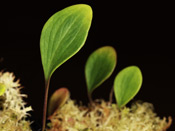
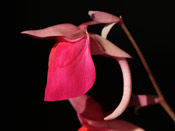
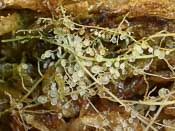
Tubers
Light: bright
Humidity: >70 %
Temperature: Summer: 20-25+ °C, Winter: 10-15 °C
Substrate: Peat-sand mixture
Watering: Water level up to substrate surface, dry season: completely dry (U. menziesii) or no water accumulation
Propagation: Tubers, seeds
Utricularia menziesii
My own experience:
A coveted species with a pretty red flower. Unfortunately, however, it is not very easy to grow, as it completely retracts into its tubers during the dry season.
The tubers can be dug out and stored in a zip bag (and protected from light). In September / October you can put them back in the substrate and slowly moisten them with a few drops of water.
As soon as the first leaves appear, you can put the pot in water or flood it completely to the substrate surface. The first flowers usually appear in January.
In April the species slowly begins to withdraw (leaves turn yellow). That is the sign of slowly watering less.
When the last leaves disappear, you can let the pot dry out. If pollinated successfully, this species produces a relatively large number of seeds,
which also have a good germination rate. The only problem is the long waiting time.
If you sow the seeds in April, some of them only germinate in January of the next year.
Level of difficulty: 
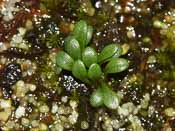
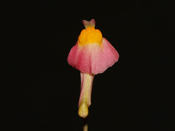
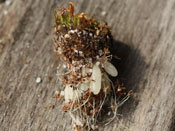
Terrestrial species (subtropical)
Light: bright - partially shady
Humidity: >60 %
Temperature: all year around 20-25 °C, but can be kept colder during winter (10 °C)
Substrate: Peat-sand mixture
Watering: Pot always in about 1 cm of water or more
Propagation: Division, seeds
Utricularia flaccida
My own experience:
Just like Utricularia alpina, Utricularia flaccida grew in my first terrarium. It immediately spread throughout the pot.
A few months later, I noticed strange little black spheres on the surface of the substrate: a slime mold that you normally don't get rid of had infested the pot.
I actually wanted to throw the whole pot away, but I decided to leave a few leaves, including runners.
Nothing came from the runners, but leaf cuttings developed from the leaves. After that, the species spread well and disappeared for a while after flowering.
The relatively thick droplets on the stem of the flowers are particularly striking.
Level of difficulty: 
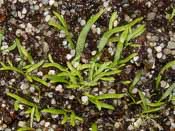
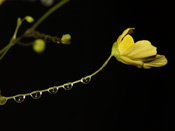
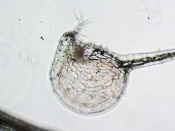
Utricularia livida
My own experience:
Utricularia livida was my first Utricularia. It is just as easy to grow as Utricularia sandersonii and is also very floriferous.
It was the first time that I brought in sciarids and even aphids. After the bitter struggle, I now know that this plant survives almost everything.
Once I got seeds from successfully pollinating a flower, but unfortunately they did not germinate.
Level of difficulty: 
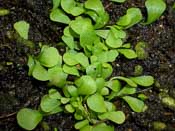
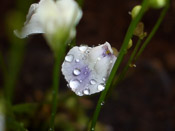
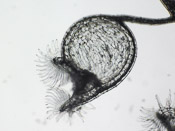
Utricularia nephrophylla
My own experience:
In the beginning, the plant developed a large number of flower stems (approx. 25). The leaves of this plant have unfortunately been eaten.
The vermins were, to my astonishment, sciarid larvae. And once again "yellow stickers" "grew" in my highland terrarium.
Unfortunately, I lost this species when trying to get rid of the sciarids with the chemical club, because the yellow stickers had not achieved the desired success.
Level of difficulty: 
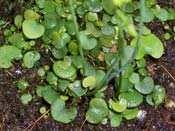
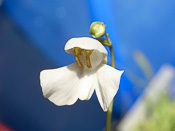
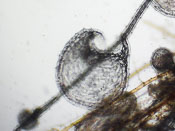
Terrestrial species (tropical)
Light: bright - partially shady
Humidity: >70 %
Temperature: all year around 20-25 °C, during winter not below 20 °C
Substrate: Peat-sand mixture
Watering: Pot always in about 1 cm of water or more
Propagation: Division, seeds
Utricularia bifida
My own experience:
I received this small species as a division many years ago.
Usually it grows quite quickly, but in winter (especially when the temperatures are too cold) it can disappear completely above ground.
It usually reappears in spring or can be propagated via seeds, which can normally be obtained in autumn.
Level of difficulty: 
